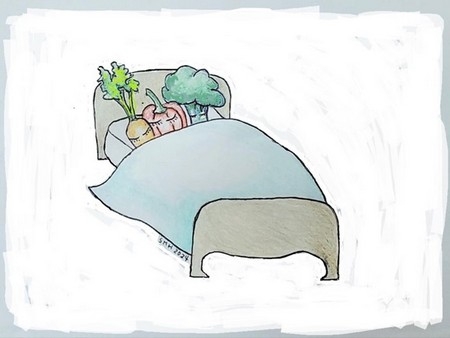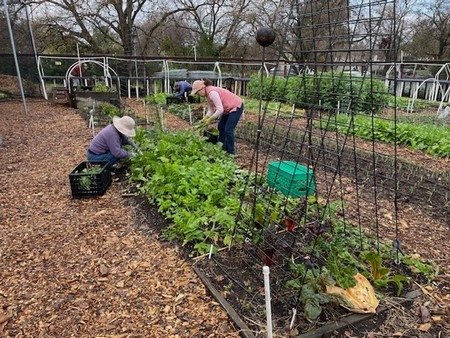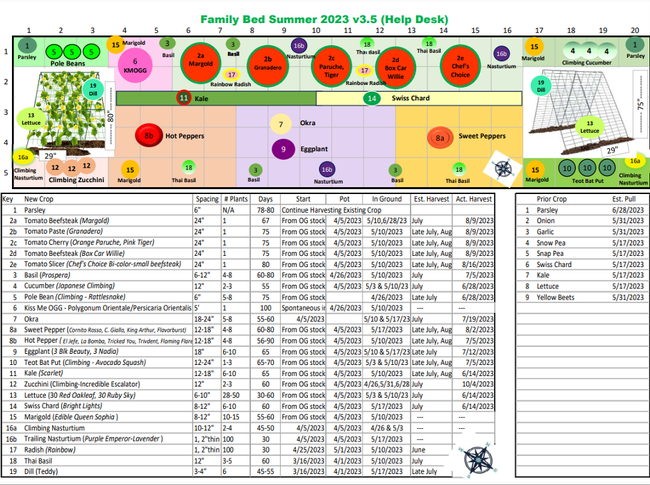Creating a Family Garden Bed
Most of us in urban and suburban areas don't have enough room for a large edible garden. Our space is limited for growing vegetables, so we need to try different techniques to maximize our yields.
The Family Garden Bed at Our Garden demonstration garden in Walnut Creek is a tangible example of what a family can accomplish when planting vegetables in their own backyard. Over the past couple of years, our 5'x20' plot has yielded roughly 500 pounds of produce each year.
Our Family Garden Bed was created 6 years ago when our garden team decided to dedicate one of our 30 existing garden plots to create and demonstrate what a family can accomplish in a small space in their own backyard. The plans for the bed evolved into a square-foot gardening concept resulting in greater vegetable yields.
Our most successful and prolific vegetable plantings are sweet potatoes, squash, onions, and tomatoes, so we plant these vegetables every year. However, we are not planning to plant sweet potatoes this season to make room for other experimental vegetables.
We have had a few failures. For example, one year we experimented with corn which took up a full square yard of space in the bed. Unfortunately, the corn provided a surprisingly low yield for our efforts. Because corn takes up a lot of space, requires a lot of water, and robs the soil of nitrogen, we no longer grow it.
The family bed continues to evolve with enhanced emphasis on edible greens that produce quite nicely during the colder months. We now have an antioxidant section featuring beets and leafy greens such as kale and spinach. We also have an “Asian” greens section featuring tatsoi and bok choy.
With the approach of spring, our Family Garden Bed Team has started to propagate seeds for the coming growing season. We plant one seed for lettuce, bok choy, tatsoi, and kale per cell in plastic six packs to get started. These seedlings will be planted in the ground in 4 to 6 weeks. Once these plants get growing, we propagate tomatoes, squash, melons, cucumbers, and other summer crops. All this is according to the master plan set down on a color-coded excel file that directs our weekly adventures.
Here is an example of our color-coded file:
OR
Here are some tips for getting the most out of every inch of space in your own Family Garden:
• Location, Location, Location: Summer crops, such as tomatoes, squash, beans, melons, and peppers all need at least 6 hours of full sun daily. A garden bed is best placed lengthwise east to west to take advantage of the sun throughout the day. Plant taller plants so they do not shade shorter plants.
• Soil and Water: Amend your soil so that you end up with what would be described as a loamy texture. Use a good compost (your own if possible), and organic fertilizers which will help build a healthy soil environment for plants over the long haul. How often you water will depend on the time of year, rainfall, how the soil retains water, the needs of your vegetables and how deep their roots grow.
• Trellising: You can maximize your bed space by trellising tomatoes, pole beans, cucumber, squash, and melons. This technique can provide shade for the lettuces that will produce longer if protected from direct summer sun.
Planning and Tracking
• Create garden plans for both warm weather and cool weather. We suggest starting small and experimenting.
• Select vegetable crops, based on what your family likes to eat, adding in something fun or new each year.
• Research and document vegetable requirements on seed packages or plant tags:
• Look up plant spacing, Days to Maturity/When to harvest, Start date to seed or plant.
• After you figure out vegetables to plant, then determine the number of plants required for your space. Since the Family Bed is 5' x 20', mini beds are designated, usually 3'x3' or 4'x4', or any configuration that will work for each vegetable. Have fun by creating a focus, such as a salsa bed, pizza bed, salad bed, antioxidant bed, etc.
Bed Layout — Getting the most out of each inch of space
• Intensive planting using the triangulation method. Place a plant at each corner of an equilateral triangle, where the length of a side is the plant spacing requirement. For example, you can plant 5 instead of 4 cabbage heads or broccoli in a 3'x3' plot.
• Intercrop planting: Mix in smaller faster-growing vegetables such as lettuce, spinach, radishes between larger, slower-growing crops such as broccoli, cabbage, cauliflower. For warm weather vegetables, plant lettuce, radishes, basil, etc., between tomato plants.
• Multi-vining tomato plants (2 to 4 vines) to get more variety of tomatoes in a bed.
• Trellising / Vertical planting: Plant upwards: indeterminate tomatoes, squash, melons, cucumbers, etc. Plant smaller, fast-growing plants under the trellis. This technique can provide shade for lettuces that will produce longer if protected from direct summer sun.
• Fill in blank spots by adding edible flowers for beauty and pollination.
Our Family Garden Bed has been a work in progress, and we learn new things every year much to our surprise! We highly recommend keeping track of what you plant each season to help you make plans for the future.
For more tips on successful gardening, check out the Edible and Sustainable gardening resources on our website: https://ccmg.ucanr.edu/
And please visit the Family Bed at our demonstration garden this spring! Our Garden is located at the southwest corner of North Wiget Lane and Shadelands Drive, just north of Ygnacio Valley Road, in Walnut Creek. We're normally open to the public from 9:00 am to noon on Wednesdays April through October.
Hope to see you at Our Garden!
Help Desk of the UC Master Gardeners of Contra Costa County (JCM)

family bed 450










